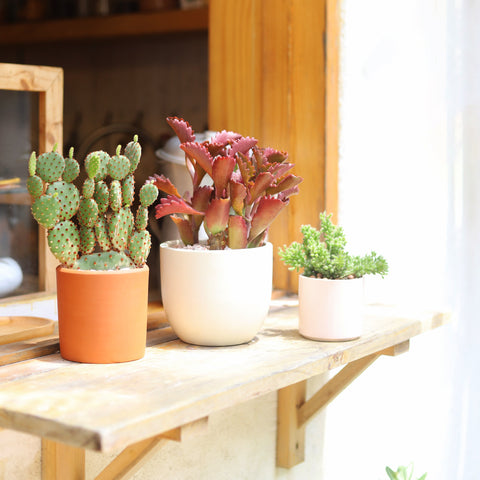Cacti, one special group of plants in the succulent family, stand out with their unique features and characteristics. Unlike other succulents, cacti possess distinct adaptations that allow them to thrive in some of the harshest environments on Earth, such as deserts and arid regions. Their iconic shapes, adorned with spines and thorns, evoke images of resilience and endurance against nature's challenges. Cacti have a remarkable diversity, with thousands of species exhibiting a wide range of shapes, sizes, and growth habits.
In our modern world, cacti have become exotic features in various indoor spaces, thanks to their remarkable adaptability to diverse environments. These hardy plants can be seen in different indoor settings. Their ability to withstand fluctuating temperatures, low humidity levels, and occasional neglect makes them popular choices for indoor gardens, offices, and homes alike. Moreover, many modern gardeners have attempted to grow cacti outdoors, in a variety of climates beyond their native habitats. Whether your cacti can thrive outdoors depends on several factors, including your local climate, outdoor conditions, your gardening expertise, and the specific species of cactus you're cultivating.
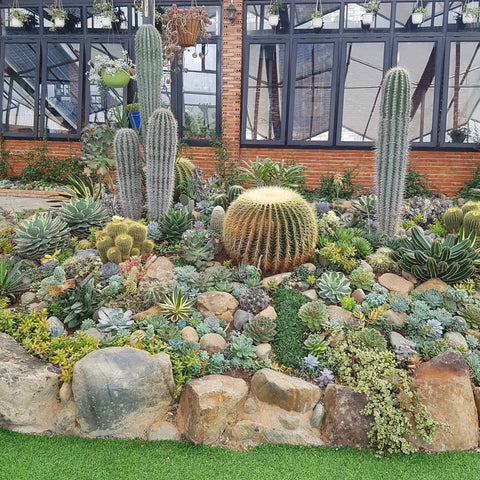
Cacti’s adaptability varies, and some species may tolerate better than others in different outdoor environments. Understanding the unique requirements and tolerances of your cactus species will help ensure its success in an outdoor setting. Factors such as temperature fluctuations, humidity levels, sunlight exposure, and soil composition directly affect your outdoor cacti. By considering these factors carefully and providing appropriate care, you can determine whether outdoor cultivation is suitable for your cacti or not.
[Types of Cacti Can Be Grown Outdoors] What Types Of Cacti Can Be Grown Outdoors?
Not all cacti are suitable for outdoor cultivation, as their ability to thrive outdoors depends on various factors such as climate, temperature, humidity levels, and sunlight exposure. While many cactus species are native to arid or semi-arid regions and can tolerate outdoor conditions, some species may prefer more sheltered environments or specific growing conditions. For example, certain tropical or subtropical cacti species may not tolerate cold temperatures or frost and may require protection from harsh weather conditions if grown outdoors in temperate climates. Similarly, some cacti species may prefer shadier or more humid environments and may not thrive in full sun or arid conditions.
Some common outdoor cactus varieties include:
- Opuntia spp. (Prickly Pear Cactus): Known for their flat, paddle-shaped stems and colorful flowers, prickly pear cacti are well-suited to outdoor cultivation in warm, sunny climates.
- Echinocactus spp. (Barrel Cactus): Barrel cacti, with their cylindrical shape and ribbed texture, are ideal for outdoor landscapes with ample sunlight and well-draining soil.
- Ferocactus spp. (Fishhook Barrel Cactus): Similar to barrel cacti, fishhook barrel cacti thrive in dry, arid conditions and are suitable for outdoor cultivation in warm climates.
- Mammillaria spp. (Pincushion Cactus): Pincushion cacti are small, globe-shaped cacti with distinctive spines and colorful flowers. They are adaptable to various outdoor environments, provided they receive adequate sunlight and well-draining soil.
- Cylindropuntia spp. (Cholla Cactus): Cholla cacti are characterized by their branching stems and spiny, cylindrical segments. They are drought-tolerant and can thrive outdoors in hot, arid climates.
- Ferocactus spp. (Barrel Cactus): Barrel cacti are renowned for their spherical shape and ribbed texture, making them well-suited to outdoor landscapes with full sunlight and minimal water.
Where In the US Can We Grow Cacti Outdoors?
Cacti can be grown outdoors in USDA hardiness zones 9 through 11, which generally encompass regions with mild to warm climates. These zones typically experience minimal frost and milder winter temperatures, making them suitable for outdoor cultivation of cacti. In zones with colder climates, cacti can still be grown outdoors, but they may require additional protection during the winter months, such as covering or bringing them indoors during freezing temperatures. It's essential to consider the specific cold hardiness of the cactus species you plan to grow and ensure that your local climate conditions align with their requirements for successful outdoor cultivation.
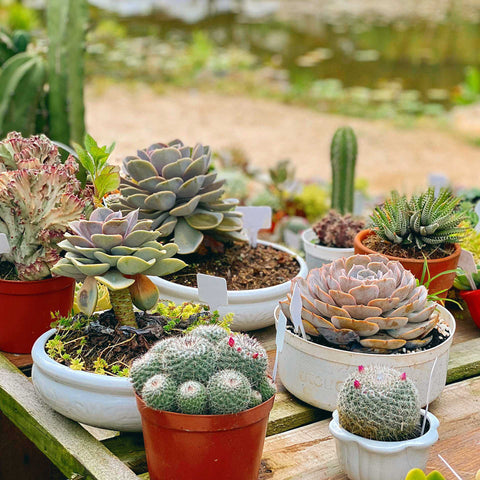
Here are some regions where outdoor cactus cultivation is feasible:
- Southwest: States like Arizona, New Mexico, Nevada, and parts of California have desert climates, making them ideal for growing cacti outdoors. Cities like Phoenix, Tucson, and Las Vegas are well-known for their thriving cactus gardens and landscapes.
- Texas: Many regions of Texas, particularly in the western and southern parts of the state, have arid or semi-arid climates suitable for outdoor cactus cultivation. Cities like El Paso, Austin, and San Antonio are popular for growing a variety of cactus species outdoors.
- Southern California: Areas with Mediterranean climates, such as Southern California, including cities like Los Angeles, San Diego, and Palm Springs, provide excellent conditions for outdoor cactus cultivation. Mild winters and low rainfall levels support the growth of various cactus species.
- Florida: Although Florida has a humid subtropical climate, certain parts of the state, particularly the central and southern regions, offer suitable conditions for growing cacti outdoors. Areas with well-drained soil and ample sunlight can support cactus cultivation in Florida.
- Southwest Colorado: Some areas of Colorado, particularly in the southwestern part of the state, have semi-arid climates conducive to outdoor cactus cultivation. Cities like Grand Junction and Durango provide suitable conditions for growing certain cactus species outdoors.
In these regions, it's essential to consider factors such as soil drainage, sunlight exposure, and winter protection when selecting and caring for outdoor cacti.
How To Grow Cacti Outdoors
Assess Your Local Climate
To grow cacti outdoors, start by assessing your local climate. Consider factors such as temperature range, humidity levels, and annual rainfall. Cacti typically thrive in arid or semi-arid climates with plenty of sunlight and minimal rainfall. Look for areas in your outdoor space that receive full sunlight throughout the day, as most cacti prefer sunny conditions. Additionally, ensure that your local climate is suitable for the specific cactus species you intend to grow, as some may have different temperature or humidity requirements. As mentioned above, the best climate areas for cacti to grow outdoors are USDA zones 9-11.
Check Soil Quality
Assessing the soil is essential for successful outdoor cactus cultivation. Optimal soil conditions mimic the well-draining, sandy, or rocky environments where cacti naturally thrive. Sandy soil allows excess water to drain away quickly, preventing root rot and other moisture-related issues. Incorporating perlite or gravel into the soil mixture further improves drainage, ensuring that water does not accumulate around the roots. Additionally, rocky soil provides stability for cactus roots while allowing air to circulate freely. By selecting the right soil composition, you can create an environment that promotes healthy root growth and overall cactus vigor.
Additionally, you should make sure the soil in your outdoor garden is fresh and free from harmful pathogens and mold is essential for the health of your cacti. Start by selecting a well-draining soil mix specifically formulated for cacti and succulents, or prepare your own by combining sand, perlite, and potting soil. Before planting, inspect the soil for any signs of mold or fungal growth, which can indicate excessive moisture or poor drainage. Avoid using soil that appears compacted or has a sour odor, as these may indicate the presence of harmful pathogens. Clean, healthy and well-draining soil is very important in creating an optimal growing environment for your cacti.
Choose Suitable Cactus Species
When selecting cactus species for outdoor cultivation, consider factors such as your climate, available space, and desired aesthetic. Choose species that are well-suited to your local climate, taking into account temperature extremes, humidity levels, and sunlight exposure. Some cacti are more cold-hardy than others, so if you live in a region with colder temperatures, choose species that can tolerate these conditions.
Additionally, consider the size and growth habits of the cactus species, ensuring they will fit well in your outdoor space and complement your landscape design. Research different cactus varieties to find ones that align with your preferences and gardening goals, whether you're looking for colorful blooms, unique shapes, or low-maintenance options.
Some cacti species are not suitable for outdoor cultivation in regions with cold climates or temperature fluctuations. These cacti are typically native to warm, desert environments and may not tolerate frost, temperature drops and changes. Examples of cacti that are not cold-hardy include Epiphyllum (Orchid Cactus), Christmas Cactus, Cactus (Gymnocalycium mihanovichii), Easter Lily Cactus (Echinopsis subdenudata) and Fishbone Cactus (Epiphyllum anguliger).
Watering Tips
When watering cacti outdoors, it's essential to consider the rainfall level in your area. If your region receives normal rainfall, your cacti may not require additional watering as they can absorb moisture from the rain. However, if your area is dry and experiences little rainfall, you'll need to supplement water to ensure your cacti remain healthy.
In dry conditions with minimal rainfall, monitor the soil moisture levels regularly. Check the soil by inserting your finger into the soil near the base of the cactus. If the soil feels dry to the touch, it's time to water. However, if the soil still feels moist, hold off on watering to prevent overwatering. When watering, ensure that water penetrates the soil deeply to reach the root system. Water the soil around the base of the cactus rather than overhead watering, as this can lead to fungal diseases. Allow excess water to drain away to prevent waterlogging.
It's important to provide good airflow around your cacti to prevent overwatering and the onset of rot. Avoid planting cacti in areas with poor drainage or where water tends to collect. Additionally, avoid overcrowding cacti to promote air circulation and prevent moisture buildup around the plants.
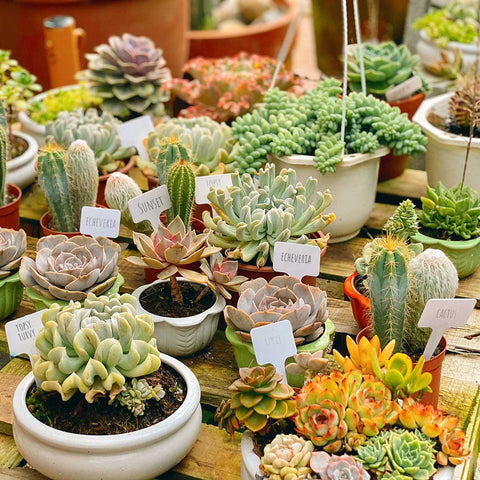
Sunlight Exposure
Sunlight is essential for the healthy growth of outdoor cacti, playing a crucial role in their photosynthesis process and overall well-being. When selecting a planting spot for your cacti, prioritize areas in your outdoor space that receive abundant sunlight throughout the day. Ideally, aim for locations with at least six to eight hours of direct sunlight exposure, although some cactus species may tolerate slightly less sunlight.
It's important to note that cacti native to desert regions are particularly adapted to intense sunlight and high temperatures. Therefore, providing them with ample sunlight in your outdoor garden mimics their natural habitat and encourages robust growth and flowering.
While cacti are known for their ability to withstand harsh sunlight and arid conditions, it's essential to monitor their exposure, especially during periods of extreme heat or intense sunlight. In some cases, prolonged exposure to scorching sun rays can cause sunburn or damage to the cactus's sensitive tissues. To mitigate this risk, consider providing partial shade or using shade cloth during peak sunlight hours, particularly in regions with exceptionally hot summers.
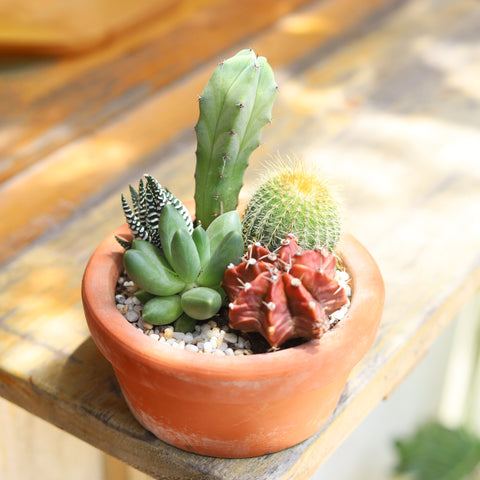
Winter Care
Cacti are generally tolerant of a wide range of temperatures, but prolonged exposure to temperatures below freezing (32°F) can be detrimental to many cactus species. Most cacti do not like temperatures below 40°F. When growing cacti outdoors, it's crucial to protect them from frost, especially if you live in regions prone to cold temperatures or frost events. Frost can be detrimental to cacti, causing damage to their sensitive tissues and potentially leading to rot or death.
To protect your outdoor cacti from frost, consider the following measures:
- Monitor Weather Conditions: Stay informed about weather forecasts, particularly during colder months or seasons when frost is more likely to occur. Keep track of temperature fluctuations and frost advisories in your area.
- Covering: When frost is forecasted, cover your outdoor cacti with frost cloths, blankets, or other breathable materials to provide insulation and protect them from freezing temperatures. Avoid using plastic covers, as they can trap moisture and exacerbate cold damage.
- Move Indoors: If possible, move potted cacti indoors or to a sheltered location such as a garage or greenhouse during frost warnings. Indoor environments typically offer warmer temperatures and protection from frost, reducing the risk of cold damage to your cacti.
- Mulching: Apply a layer of mulch around the base of outdoor cacti to provide additional insulation and protect their roots from freezing temperatures. Organic mulches such as straw, pine needles, or shredded bark can help retain soil warmth and prevent frost damage.
Pests And Animals
When growing cacti outdoors, it's essential to be mindful of potential pests and animals that may pose a threat to your plants. Here are some tips to help manage pests and protect your outdoor cacti:
- Inspect Regularly: Routinely inspect your cacti for signs of pest infestation, such as chewed or damaged areas, discoloration, or the presence of insects.
- Identify Pests: Learn to recognize common pests that affect cacti, such as aphids, mealybugs, scale insects, spider mites, and snails. Identifying the specific pest will help you choose the most effective control methods.
- Natural Predators: Encourage natural predators of common cactus pests, such as ladybugs, lacewings, and predatory mites, by creating a diverse and balanced ecosystem in your garden.
- Treatment: For small infestations, manually remove pests from your cacti using a soft brush, cotton swab dipped in rubbing alcohol, or a gentle spray of water. Apply neem oil or insecticidal soap to affected areas of the cactus to control pests. These organic remedies are safe to use and effective against a variety of common garden pests.
- Barrier Methods: Create physical barriers around your cacti to prevent access by pests and animals. This may include installing wire mesh or plastic barriers around the base of the plants or using row covers to protect them from flying insects.
- Natural Repellents: Consider using natural repellents, such as diatomaceous earth, crushed eggshells, or coffee grounds, around your cacti to deter pests and animals.
- Companion Planting: Plant companion plants that repel pests or attract beneficial insects near your cacti. For example, planting aromatic herbs like lavender or rosemary may help deter pests.
- Proper Hygiene: Maintain good garden hygiene by removing plant debris, fallen leaves, and weeds that may harbor pests or provide hiding places for animals.
- Fencing: Install fences or barriers around your garden to keep out larger animals, such as rabbits, deer, or rodents, that may feed on or damage your cacti.
Extra Tips
When choosing between planting your cacti directly in the ground or containers, consider the advantages and disadvantages of each option. Planting cacti directly in the ground provides them with more space to spread their roots and can create a natural-looking landscape. Additionally, cacti planted in the ground may be more resistant to temperature fluctuations and less likely to become waterlogged compared to those in containers. However, planting in the ground requires careful consideration of soil conditions, drainage, and potential frost exposure.
On the other hand, container planting offers greater flexibility and control over soil composition and drainage. You can easily move container-grown cacti to different locations to optimize sunlight exposure or protect them from extreme weather conditions. Containers also allow you to create attractive arrangements with multiple cacti of different shapes and sizes. However, container-grown cacti may require more frequent watering and fertilization compared to those planted in the ground. Additionally, containers can restrict root growth, potentially leading to root-bound plants over time. Consider your gardening preferences, space constraints, and climate conditions when deciding whether to plant your cacti in the ground or in containers.
Avoid overcrowding your outdoor cacti garden or container arrangement. While it may be tempting to fill every available space with cacti, overcrowding can lead to competition for resources such as sunlight, water, and nutrients. This can result in stunted growth, poor overall health, and increased susceptibility to pests and diseases. Instead, give each cactus enough space to grow and spread out comfortably. This not only promotes healthier growth but also enhances the aesthetic appeal of your cactus garden or arrangement. Remember to consider the mature size of each cactus species and leave ample space between plants to accommodate their growth over time. By avoiding overcrowding, you can create a visually pleasing and thriving outdoor cactus display.
When selecting a location for your outdoor cactus garden or container setup, avoid areas that are prone to sloping or uneven. Sloped areas can pose several challenges for cacti, including water runoff, soil erosion, and instability. Excess water from rainfall or irrigation may not be properly absorbed by the soil in sloped areas, leading to water pooling or runoff that can drown or rot cactus roots. Additionally, soil erosion caused by sloping terrain can expose cactus roots, making them vulnerable to damage and dehydration.
Moreover, choose a sheltered spot for your outdoor cacti garden or container arrangement to avoid exposure to strong winds. Windy conditions can lead to soil erosion, root exposure, and even bending or damage to cacti. Look for areas that are protected from prevailing winds, such as against a wall or near larger plants or structures that can provide natural windbreaks.
